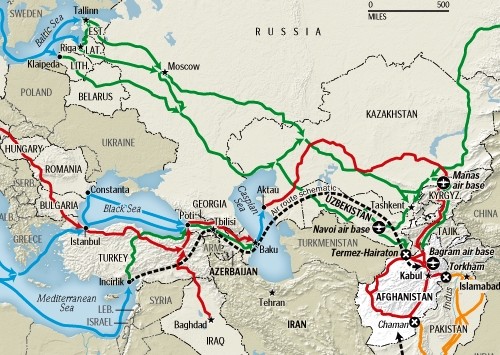Afghanistan withdrawal logistics at risk for Ukraine
In
Log in if you are already registered
One of the most important leverages that Russia has on the american foreign policy is the main branch of the Northern Distribution Network (NDN), a supply line that reaches Afghanistan from Europe after crossing Russia, Khazakhstan and Uzbekistan. The route was built up in 2008 as alternative to the distribution line through Pakistan, which is connected to Afghanistan by only two mountain passes in the insurgent areas and was deeply instable and duplicitous towards the US. In 2008 Islamabad shut down the line to retaliate against the death of 24 military officers accidentally killed by an american jet fighter, a few months later the Pentagon came up with the NDN to grant the supply of non-lethal materials to the troops. In two years more than 50 percent of the refuelings was delivered to Afghanistan through this line, weapons included.

The NDN: railways in green, trucks in red, airways in black ( partially depicted). Pakistani routes in yellow.
The NDN is going to play a fundamental role in the massive withdrawal of the american troops scheduled for the end of 2014: thousands of soldiers, millions of weapons and other lethal and non-lethal materials will be retrasported to Europe through this path. Thus, the fate of the operation depends someway on Russia. Strangely the crisis in Ukraine and the tensions that followed have left unchanged, up to now, the deal between the two countries. There are some very “realpolitik” reasons for that.
First of all, the american military presence in Afghanistan is considered by the Kremlin to be an important factor of security and stability in the entire area. The plan for an early withdrawal sparked concern among russian policymakers and military chiefs. The foreign minister Sergei Lavrov even stated in 2012 that it was too early for America to leave the country to itself. Indeed, it is wide spread the fear that Afghanistan could soon fall in a spiral of violence and civil strife once again, and that islamist forces and jihadists, beside taking over the country, could move freely towards the Former Soviet Republics, Russia included. Central Asia has been the stage over the last years of an increasing islamist militiamen activism. Uzbekistan is base of a big terrorist group operating in Afghanistan (the Islamic Movement of Uzbekhistan) and Tajikistan and Kazakhstan have faced a wave of terrorist attacks. The unsolved issues in Northern Caucasus already pose a big threat to Russia, which is definitely unwilling to see another centre of jihadism in the South East. In a nutshell, for the moment it is in Russia’s interests not to jeopardize the mission.
Moreover, economic and political issues are also at stake. The NDN means a huge amount of money for the hosting countries. Uzbekistan, Kyrgyzstan and Kazakhstan have all raised up their customs duties since the route was established and transports largely rely on local businesses. Since transits are both on ground and airfreighted , the use of infrastructures and airspace authorizations make millions in revenues (the path is longer than 5000 km most of which within Russia). An article on The Guardian stated in 2012 that the general cost of the NDN was up to 103 million dollars per month, but the huge reversal flow of men and goods from 2014 on is going to increase even further the costs of the operation. Finally, alleged (and very probable) cases of corruption are standard procedures. Many commentators have criticized the United States for directly enriching the central asian strongmen, whose policies towards the local populations can hardly fit the western standards. In Uzbekistan, after the White House used hard words for the abuse of human rights, president Karimov shut down an american military base (generally another huge source of income and bribery) and threatened to do so with the entire network, forcing the White House to take everything back and showing who actually runs the game. Other states of the area, Kazakhstan and Kyrgyzstan, have similarly blackmailed the US in order to gain the most from the american presence. Indeed, the NDN has increased the strategic importance of these countries and enabled them to take advantage of a new international status never enjoyed before.
Russia has used some of these contentions to play as counterbalance and rival of the US in Central Asia despite the collaboration over Afghanistan. But Moscow could now use its power on the main american commitment abroad in the showdown against the West over East Ukraine and Crimea. If the situation in Ukraine is to worsen further, Russia knows that the NDN is a powerful tool to discourage America from more aggressive actions. From silent deterrent, cutting the NDN could become an open threat. In fact, despite Joseph Dunford, the american top commander in Afghanistan, recently stated that the redeployment of troops would go through even without the northern supply line, a suspension of the network would be a major blow in the strategy of the White House. A total dependence on Pakistan and Turkmenistan, where passes another minor route, could turn the logistics of the withdrawal into a nightmare and waste all the economic and political efforts prior made.




